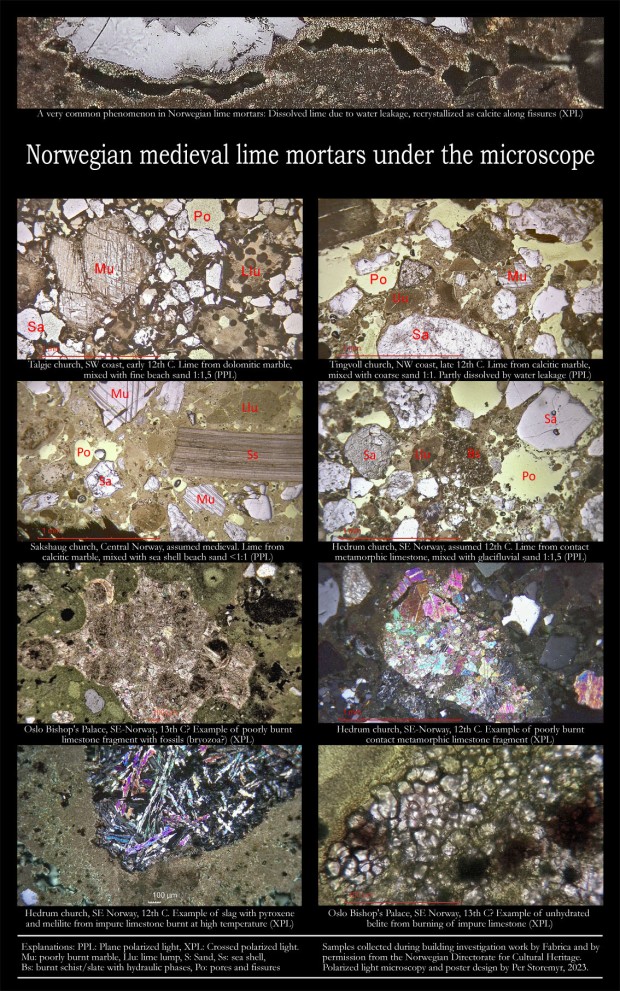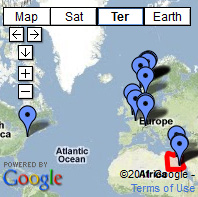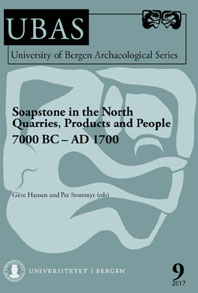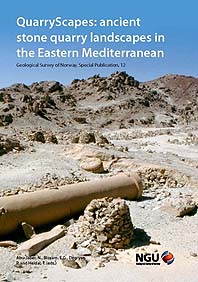Happy New Year to all my readers!
Having burnt lime the small-scale, traditional way for some time, over the last couple of years my interest in the fascinating world of old Norwegian lime mortars has intensified. As 2023 draws to an end, I want to share a few microphotos from investigations of medieval mortars under the polarized light microscope. It is a world closely connected to the diverse geology of Norway, but also to burning temperatures in the old kilns.

A taste of Norwegian medieval lime mortars under the microscope. Images by Per Storemyr. Click on image for higher resolution.
Traditional lime burning in Norway took place in regions with Precambrian and Caledonian crystalline marble along the west coast and in the central part of the country, as well as in the limestone districts along the flanks of the Permian Oslo Rift. In the latter, also contact metamorphic limestones occur close to Permian intrusives. Hundreds of kilns were in operation. Today there is, unfortunately, only one commercial lime burning facility left in the country.

Lime resources in South Norway. Clusters of resources define traditional lime burning districts. Geology from The Geological Survey of Norway, adapted by Per Storemyr
Generally, Norway’s marbles are purer than the country’s limestones, implying that lime from the former are either air limes or limes with only weak (feebly) hydraulic properties. The limestones are more diverse, on burning giving everything from air limes and feebly hydraulic ones to “real” natural hydraulic varieties.
However, burning temperatures were, of course, also very important for which types of limes that came out of the kilns. Traditional wood-fired kilns are often notorious for their varying burning temperatures. Very low – and very high – temperatures can also be deduced from the mineralogy and texture of the limes, as seen under the microscope.

Norwegian medieval lime mortars under the microscope: Top left: Underburnt limestone fragment. Top right: Underburnt contact metamorphic limestone fragment. Bottom left: Slag from burning impure limestone at high temperature. Bottom right: Unhydrated belite from burning impure limestone at moderate-high temperature. Microphotos by Per Storemyr
I have become particularly fascinated by slag formation from burning of impure limestones at high temperatures. This is because, on small-scale burning of impure limestones today, we occasionally encounter minor amounts of liquid slag that may literally pour out of the lime lumps in the high temperature lower parts of the kilns (>1100°C). These slags are rich in pyroxene and melilite-group minerals, which is exactly what we may find in slag fragments in old lime mortars. Such investigations, by microscopy aided by X-Ray Diffraction analyses, help determine whether slag was added to the mortar – or simply was a result of limestone quality and burning temperature.

Slag in mortar and lime lumps burnt at high temperatures. Left: mortar from the 12th C Hedrum church, SE Norway. Right: impure, fossil-rich, Silurian limestone burnt in our small kiln at the south coast in 2023. Scale is in cm. Photos by Per Storemyr
There are many more themes to be addressed about traditional Norwegian lime mortars. Together with colleagues Tore Granmo and Terje Berner, I have just published an overview of what we have learnt from small-scale lime burning, mortar investigations and historic studies over the last 25 years. Key is great diversity! Here’s the publication, still only in Norwegian:
- Storemyr, P., Granmo, T. & Berner, T. (2023): Småskala kalkbrenning. Geologisk mangfold i kulturminnevernets tjeneste. Fortidsminneforeningens årbok, 177, s. 53-76 [Small-scale lime burning: Geological diversity in the service of cultural heritage conservation]. To be obtained from the authors. Pictures from the article here.







Pingback: Tradisjonell kalkbrenning i små, vedfyrte ovner. Erfaringer fra 6 brenninger i Tvedestrand | Per Storemyr Archaeology & Conservation
Hi Per,
I made a mention of your latest research in /Stone-Ideas.com/:
https://www.stone-ideas.com/104340/woman-is-best-stonemason-in-france/
Thnaks for keeping me updated.
All the best
Peter
/Stone-Ideas.com/
Peter BECKER, Editor-in-chief/Publisher
Tel: +49 (0)30 216 7944
https://www.stone-ideas.com
Pingback: Best stonemason in France for the first time a woman
Tusen takk for en fin artikkel Per. Riktig godt nytt år! Vi sees I forbindelse med Hoff kirke Hilsen Terje
Takk for det! Godt nyttår!